Council Housing and Dwelling Assumptions
Within Place Forecast, we project dwellings. You, dear client, can influence how we project dwellings via dwelling assumptions.
Dwelling assumptions are an input to your forecast in the form of a client dataset. This dataset contains changes to the dwelling projections based on local council data, such as additional dwellings in the future or reductions to existing dwelling stock.
This document describes the data structure of the dwelling assumptions dataset and its effect on dwelling projections.
Some Considerations for Dwelling Assumptions
- Assumptions are applied to small area forecasts.
- Dwelling assumptions lead to dwelling assumption adjustments of dwelling projections. Housing assumptions lead to housing assumption adjustments of average household size and population in dwellings.
- Assumptions can only affect projected data, never estimated data.
- Assumptions can be expressed in any of one of these categories:
- Addition relative to the current amount of projected dwellings,
- Reduction relative to the current amount of projected dwellings or
- Override to a target number of projected dwellings.
- Applying a ceiling to constrain projected dwellings to a maximum.
- These categories will be applied in the following order:
- Additions
- Reductions
- Overrides
- Ceilings
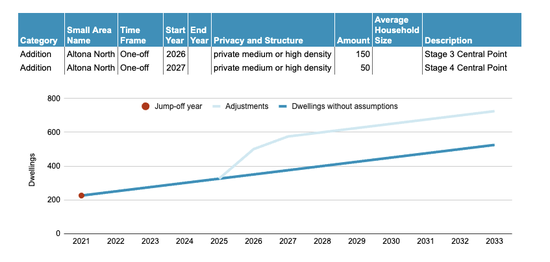
Example: Adding Dwellings Once I
Example: Adding Dwellings Once I
In the small area of Altona North, a building project named Central Point finishes its 3rd stage in the year 2026 with 150 extra dwellings on top of the current projections and it’s 4th stage in the year 2027 with 50 extra dwellings on top of the current projections. All these dwellings are private and medium or high density.
Approach: Add 150 private medium or high density dwellings as a one-off in 2026 to the dwelling projections for the small area of Altona North, and then 50 more as a one-off in 2027.
Example: Adding Dwellings Repeatedly
In the small area of Altona North, a building project named Central Point finishes its stages 5 to 9 in the years 2027 to 2031. In each of these years, 200 extra dwellings are going to be completed on top of the current dwelling projections. All these dwellings are private and medium or high density.
Approach: Add 200 private medium or high density dwellings every year in the time span starting in 2027 and ending in 2031 to the dwelling projections for the small area of Altona North.
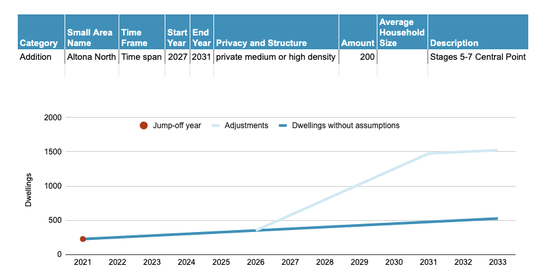
Example: Adding Dwellings Repeatedly
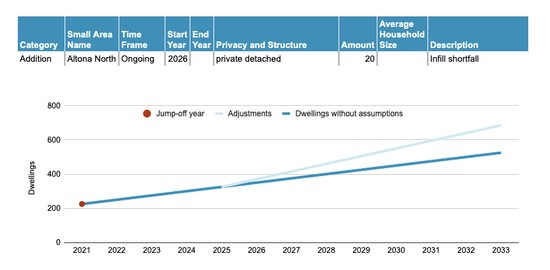
Example: Adding Dwellings Ongoing
Example: Adding Dwellings Ongoing
The small area of Altona North expects to experience an infill increase from a zoning change. From 2026 onwards, 20 private detached dwellings will be added on top of the current dwelling projections for each year.
Approach: Add 20 private detached dwellings from 2026 on an ongoing basis each year to the dwelling projections for the small area of Altona North.
Example: Reducing Dwellings Ongoing
In the small area of Altona North, to compensate for a capacity constraint, from 2030 onwards, for each year, the current dwelling projections are reduced by 20 private detached dwellings.
Approach: Reduce the dwelling projections by 20 detached dwellings from 2030 on an ongoing basis each year for the small area of Altona North.
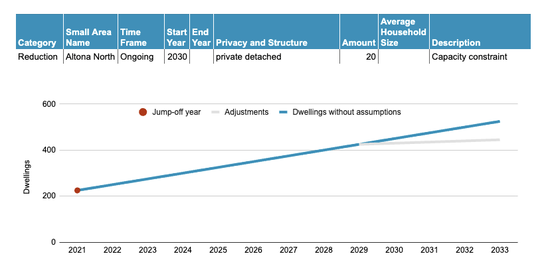
Example: Reducing Dwellings Ongoing
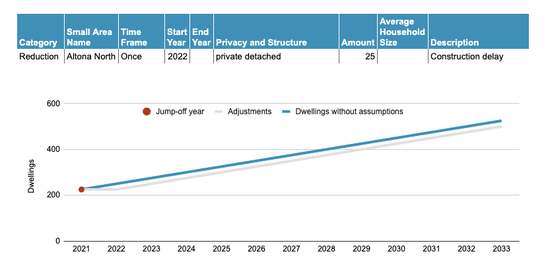
Example: Reducing Dwellings Once II
Example: Reducing Dwellings Once II
The small area of Altona North experienced a construction delay that has not been reflected between the building approvals and completions yet. As a result, the currently projected dwellings need to be reduced by 25 dwellings once as an offset.
Approach: Reduce the dwelling projections by 25 detached dwellings for 2022 for the small area of Altona North.
Example: Adding Non-private Dwellings
In the small area of Altona North, a new prison will become active in 2031. It has a capacity of 500 people. This area already has two non-private dwellings with an average household size of 134 people per dwelling.
Approach: Add one single non-private dwelling as a one-off in 2031 to the dwelling projections for the small area of Altona North, with an average household size for this building of 500 people per dwelling. This approach changes the average household size for non-private dwellings to 256 people per dwelling.
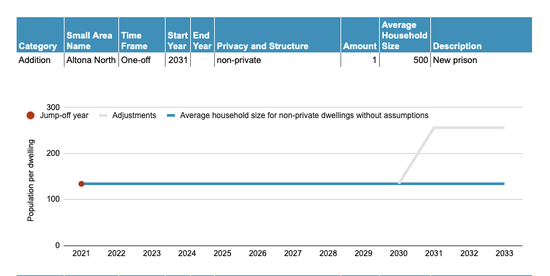
Example: Adding Non-private Dwellings
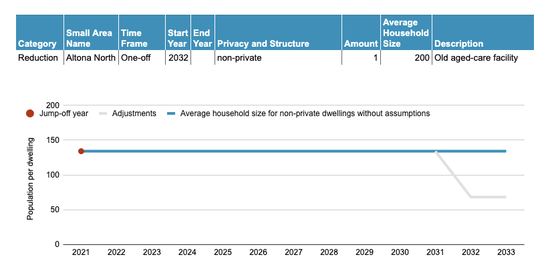
Example: Reducing Non-private Dwellings
Example: Reducing Non-private Dwellings
In the small area of Altona North, an old aged-care facility will be retired in 2032. It has a capacity of 200 people. This area already has two non-private dwellings with an average household size of 134 people per dwelling.
Approach: Reduce the current dwellings by one single non-private dwelling as a one-off in 2032 to the dwelling projections for the small area of Altona North, with an average household size for this building of 200 people per dwelling. This approach changes the average household size for non-private dwellings to 68 people per dwelling.
Example: Override Dwellings Ongoing
In the small area of Altona North, a building project named Central Point is expected to be finished by 2030. It is the only building project in this small area at this point. From 2031, the overall dwelling capacity of 450 dwellings will be reached.
Approach: Override the current dwelling amount to 450 dwellings from 2031 onwards.
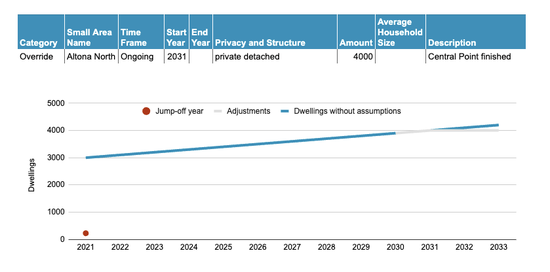
Example: Override Dwellings Ongoing
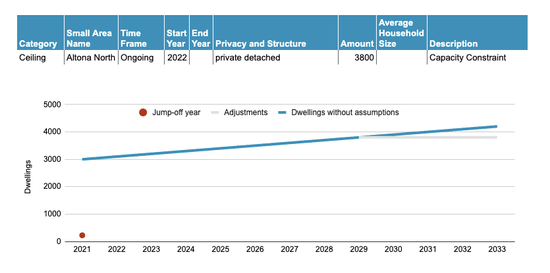
Example: Ongoing Ceiling for Dwellings
Example: Ongoing Ceiling for Dwellings
An analysis of the small area of Altona North has shown that, as of 2022, the overall capacity cannot exceed 3800 private detached dwellings.
Approach: Create a ceiling of 3800 dwellings from 2022 onwards.
Field Reference
This is a description of each column in the table and what it can and cannot do.
Housing and dwelling assumptions are an input to your forecast in the form of a client dataset. Assumptions lead to adjustments of dwelling data based on local council data, such as additional dwellings in the future or reductions to existing dwelling stock. The result of these assumptions are either dwelling assumption adjustments or housing assumption adjustments.
The file needs to include the words housing, dwelling, and assumptions. The file needs to end in .xlsx.
Category
Mandatory. The category of housing and dwelling assumption. Can be
addition(adding to the current dwellings)reduction(reducing the current dwellings)override(overriding the current dwellings)- ceiling (constraining to a maximum of the current dwellings)
Small Area Name
Mandatory. The name of the small area to which this assumption will be applied. It needs to be exactly the same name as one of the small areas in your forecast.
Time Frame
Mandatory. The kind of time frame that this dwelling assumption will be applied to. Can be
One-off(this dwelling assumption will be applied to the single year specified in the fieldStart Year)Time span(this dwelling assumption will be applied to the year specified in the fieldStart Year, to the year specified inEnd Year, and to all years between those two years)Ongoing(this dwelling assumption will be applied to the year specified in the fieldStart Yearand to all the subsequent years present in the projection horizon)
Note that the assumption categories Override and Ceiling can only use the Ongoing time frames.
Start Year
Mandatory. The year in which the dwelling assumption will first be applied to. Works together with the field Time Frame.
End Year
Mandatory for the time span time frame only; ignored otherwise. The year in which the dwelling assumptions will be applied to last. Works together with the field Time Frame.
Privacy and Structure
Mandatory. To which kind of dwelling category this dwelling assumption will be applied to. Can be
private detachedprivate medium or high densitynon-private
Amount
Mandatory. The amount of dwellings that this dwelling assumption represents. Must be a positive integer (1, 2, 3, …, 100, …).
Average Household Size
Mandatory if privacy and structure is non-private; ignored otherwise. The average household size (average amount of people per dwelling) of the non-private dwelling that is described by this dwelling assumption. Must be a non-zero positive number that can include decimal places.
Description
Mandatory. A description that justifies the existence of this dwelling assumption. Can be any string, but must be unique together with the small area name.
